Table of contents
- Restoration of the BMW R 80 G / S Part 4, engine and carburetor adjustment
- Discoloration of the candle insulator
- Output configuration of the boxer
- Drivability on narrow, winding roads is a priority
- BMW R 80 G / S on the dynamometer
- Subjectively noticeably more powerful start
- The richer the mixture, the higher the performance
- Measured values BMW R 80 G / S
- Growth especially from 4000 rpm

Cook

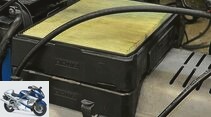
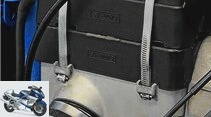
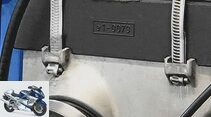
23 pictures

Cook
1/23
Small and big changes make the almost 70 hp of the renovated R 80 G / S.
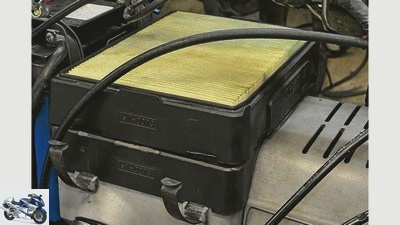
Cook
2/23
The new, original air filter sits on this base. This increases the volume by around 30 percent.
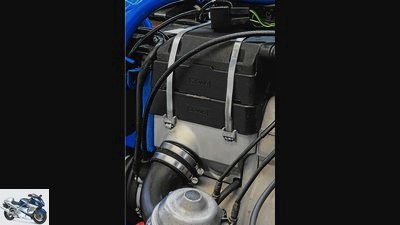
Cook
3/23
Two hose clamps each replace the spring clips. The bracket of the relay (above) must be shortened.
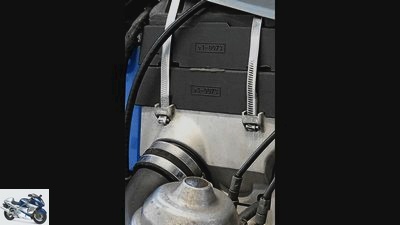
Cook
4/23
The enlarged air filter housing fits under the standard tank of the BMW R 80 G / S without any further changes.
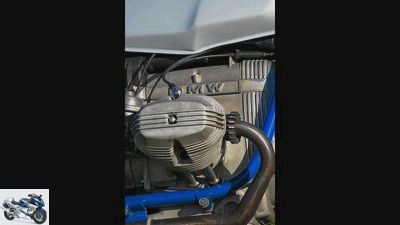
Cook
5/23
Conical manifolds with 38 and 45 millimeters in diameter are designed to combine good torque and power.
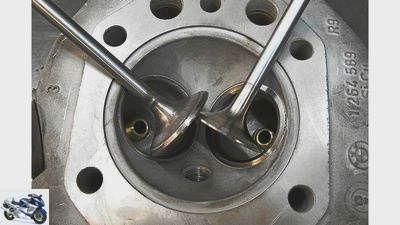
Cook
6/23
Valve plates and seats have been slightly rounded and disturbing edges in the flow area have been removed.
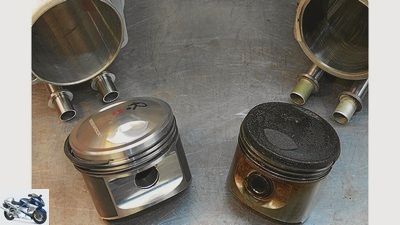
Cook
7/23
The Siebenrock Power Kit has proven itself a thousand times over and does it
R 80 boxer engines really have legs.
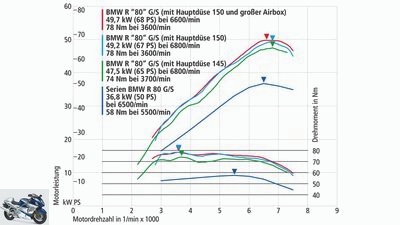
Cook
8/23
The changes to the carburettor and air filter can be objectively checked and measured on the test bench at full load.

Cook
9/23
The different settings showed their effect on the Dynojet roller dynamometer.

Cook
10/23
BMW R 80 G / S, part 4: engine carburetor adjustment.
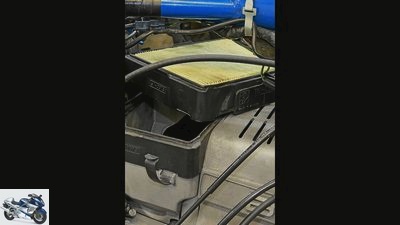
Cook
11/23
Cut the paper out of the old air filter plate (1) and cut the lateral guide ribs.
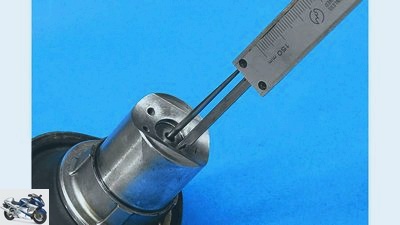
Cook
12/23
To be on the safe side, measure the needles after inserting them into the clips. Approx. 1.8 mm difference per grid position.
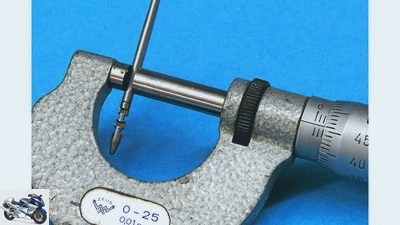
Cook
13/23
The nozzle needles in the cylindrical part were made with 800 lapping lines
2/100 millimeters removed.
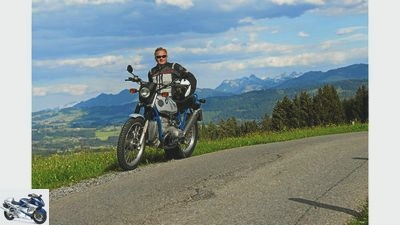
Cook
14/23
BMW R 80 G / S, part 4: engine carburetor adjustment.
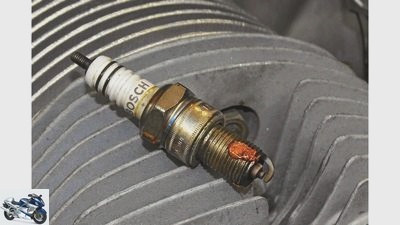
Cook
15/23
Assuming the appropriate heat value, the candle image (discoloration of the central insulator) allows relatively reliable conclusions to be drawn about the combustion.
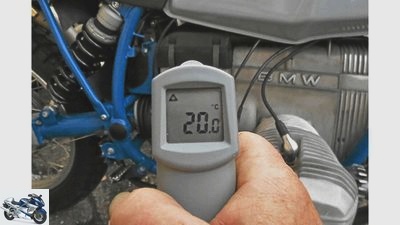
Cook
16/23
The air filter housing, shielded from the hot engine by rubber elements, is significantly cooler at 20 degrees …
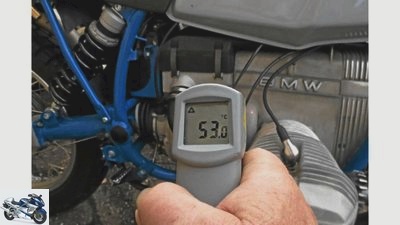
Cook
17/23
… than the engine / transmission block below. Thanks to the decoupling, the intake air is less preheated.
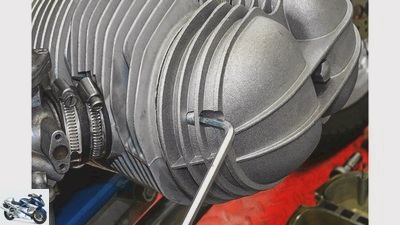
Cook
18/23
Siebenrock’s round valve covers are also available with 6mm screws.
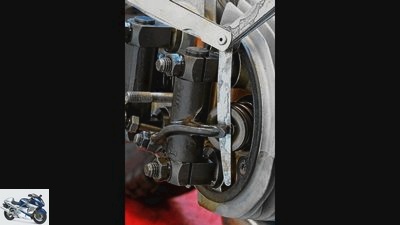
Cook
19/23
The valve clearance, which was adjusted to 0.15 / 0.20 millimeters as standard, had to be corrected after the first 1000 kilometers. A play of 0.20 / 0.25 millimeters stabilizes the idle behavior.
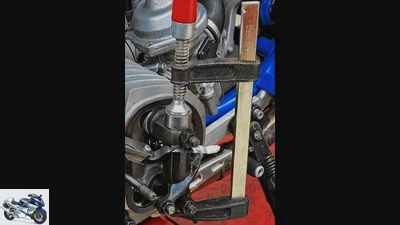
Cook
20/23
Reducing the axial play with a screw clamp and a 0.05 feeler gauge improves the acoustic running smoothness.
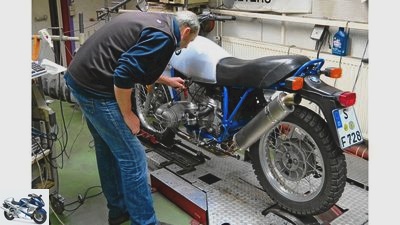
Cook
21/23
Changes in the ignition timing changed the idle, but not the performance.
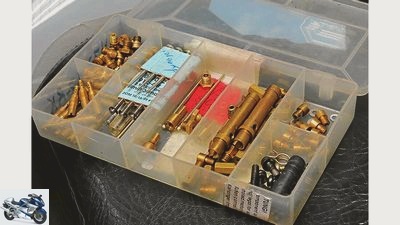
Cook
22/23
The collection of nozzles that has accumulated over the years makes it easier to choose when coordinating.

Cook
23/23
BMW R 80 G / S, part 4: engine carburetor adjustment.
counselor
workshop
Restoration of the BMW R 80 G / S part 4 engine and carburetor adjustment
Restoration of the BMW R 80 G / S
Part 4, engine and carburetor adjustment
Content of
After countless hours in the workshop, the coordination of consumption and performance was on the plan. With a nozzle box and a candle wrench in the luggage, we went across the beautiful Allgau.
Werner Koch
02/05/2015
Although the maiden voyage (see restoration of the BMW R 80 G / S, part 3) went off the stage with the newly built BMW R 80 G / S without any mechanical incidents, I was not really enthusiastic. The smooth running of the engine couldn’t hide the fact that the boxer, inflated to 980 cubic centimeters, didn’t really get going. Noticeably more powerful than the worn out original 800 engine, but not as muscular and powerful as I had imagined after the comprehensive complete renovation.
Buy complete article

Restoration of the BMW R 80 G / S
Part 4, engine and carburetor adjustment
6 pages) as PDF
€ 2.00
Buy now
So I took another look at all the relevant components and settings. From a purely subjective point of view, the two-valve engine felt as if it was out of breath. Somehow strangled, strangled, short of breath and yet clearly too thirsty with almost 6.5 liters of country road consumption. However, since we didn’t want to tinker with a racing engine for the nimble Enduro, but only wanted to turn it into a lively yet economical everyday mule, we did without lambda measurements and expensive engine tuning with camshafts and double ignition. Only the thermal decoupling of the aluminum air filter housing from the hot engine block should give the engine a little more “air” in continuous operation (see MOTORRAD Classic 2/2015).
Discoloration of the candle insulator
As learned from scratch, the discoloration of the candle insulator and practical driving tests were sufficient to assess the thermal state of the combustion. A dollop of copper paste on the candles and a gentle torque when tightening protect the sensitive threads in the cylinder head.
After a few hundred kilometers, a thin deposit has already formed on the insulator, which – depending on the spray and load – changes its color accordingly. Completely new candles, on the other hand, hardly allow any conclusions to be drawn about the combustion, because the insulator is only very weakly discolored. Nevertheless, a test drive with modified nozzles should take a good ten to 15 kilometers to guarantee a meaningful candle image.
Output configuration of the boxer
The initial configuration of the boxer engine was as follows:
- 32 Bing carburetor, main jet 135, needle jet 168, needle in the third position from the top
- Air filter cover with a large and a small snorkel
- Exhaust manifold with conical shape (38/45 mm diameter)
- Termignoni silencer from a Suzuki TL 1000 S.
- Valves and seats rounded and flow-optimized
- Ignition, air filter and compression as standard
With this setting, as mentioned, the engine swallowed properly, slowed down on the accelerator and responded with a delay when it was wound up, but without jerking. Subjectively, there was a lack of revving and power in the upper engine speeds, while the rough cold run and poor starting behavior were annoying in the lower partial load operation. In addition, after the first long stretch of the motorway, there was an unstable idle gas that could hardly be regulated. So reasons enough to completely turn this vote upside down.
Anyone who dares to venture into new territory with the boxer project should be aware that the Munich two-valve engine has properties that are alien to the rock-solid Japanese youngtimers. Keyword valve clearance: Adjusted according to the manual (0.15 / 0.20 mm), the freedom of movement had already shrunk to less than 1/10 millimeter after the first 1000 kilometers. With the result that the combustion is subject to an annoying fluctuation when idling. The cause of this is to be found in the unfavorable, hemispherical combustion chamber, the low compression and the slightly changed timing when the valve clearance is too tight. The extremely low cylinder charge when idling then causes combustion to vary in efficiency from work cycle to work cycle with strongly fluctuating working pressure.
Drivability on narrow, winding roads is a priority
With the play increased to 0.20 / 0.25 millimeters, the problem was abruptly resolved! In order to reduce the mechanical noise, especially when idling, the axial play of the rocker arms was reduced to less than 0.05 millimeters by clamping the bearing blocks together. The eye is also pleased that the angular valve covers have been exchanged for the classic, round version. So that the Siebenrock components can be dismantled quickly and without fumbling with continuous hexagon socket screws, two six-millimeter helicoil threads were used in the cylinder head.
To enumerate all attempts with the most varied of sprays in detail would go beyond the scope. The focus in the time-consuming search for the right sprinkler system for the boxer engine was clearly on drivability on narrow, winding roads. Which is why the southern Allgau, with its pass roads, some of which are over 1,400 meters high and endless bends, including adventurous gravel passages, offers exactly the right terrain for comprehensive coordination – quite apart from the driving pleasure.
BMW R 80 G / S on the dynamometer
Spontaneous throttle response, zero constant jerking, smooth revving, perfectly healthy combustion noises and an average of 5.3 liters of super – after a good 200 test kilometers and around a dozen set-up options, the renovated boxer finally purrs as desired through the hilly pre-alpine landscape. In order to check the subjectively effective changes in the coordination with facts and figures, we put the restored BMW R 80 G / S on our incorruptible performance test bench. There, the changes made on the Allgau country roads were reproduced and finally put on paper in several test runs for each setting.
In addition, by changing the standard ignition timing (32 degrees advance ignition) by three degrees in both directions, we wanted to clarify whether this very simple measure could squeeze out even more torque. The engine always reacted to this with a fluctuating idle speed and slight loss of performance. So hands off with series engines without targeted change of the adjustment curve, especially since the material-destroying ringing with more advanced ignition under unfavorable circumstances (bad cooling, bad fuel) would damage the engine considerably!
Subjectively noticeably more powerful start
On the test bench, which in principle only records a full load performance curve (throttle valves and throttle slide fully open), more volume in the air filter housing brought a slight improvement across the entire speed range. When driving, the subjectively noticeably more powerful start of this relatively easy-to-use measure ensures a broad grin. No wonder, especially in the case of sporty two-cylinder engines, the designers are trying to bring the volume of the air filter box to around ten times the displacement. The Boxer ran best with this configuration:
- 32 Bing carburetor, main jet 150, needle jet 164, needle reduced by 2/100 mm, second position from the top
- enlarged air filter housing with two large snorkels in the lid
The richer the mixture, the higher the performance
Whether and to what extent the self-designed exhaust influenced the performance development cannot be answered because of the lack of a comparison option. However, the conical manifold design with 38 and 45 diameters has already proven itself in some large-volume racing engines. The trick with the nozzle needle ground by 2/100 millimeters on the cylindrical part is also perfect. This significantly improves the part load behavior due to the enrichment up to about half throttle. In combination with the small 264 needle nozzle, however, there are clear advantages in terms of consumption without reducing performance. A clear indication that the old saying “no fun without fuel” applies especially to the BMW two-valve engines. The test bench with different main nozzles shows: the richer the mixture, the higher the performance. Which is why the theoretically optimal lambda value of 1.0 for all revamped four-stroke engines with up to around 0.8 is based on a significant excess of fuel in order to get a decent performance.
As mentioned, the performance competition in the two-valve scene played no role in this MOTORRAD Classic project. The focus here is on suitability for everyday use and driving fun on the smallest of roads and slopes. The measured 68 hp are more than enough for that. And 188 kilograms with a full tank is just right. Provided that you get the best out of the suspension, chassis and brakes. You can read about what is important in MOTORRAD Classic 4/2015.
Measured values BMW R 80 G / S
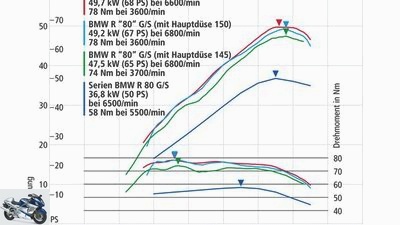
Cook
Readings of the revised boxer.
The changes to the carburettor and air filter can be objectively checked and measured on the test bench at full load. Here you can clearly see that the revised boxer with 145 main jets suffers from two significant torque drops at 3000 and 4000 revs (green).
Growth especially from 4000 rpm
With the 150 main jets, the power increases over the entire speed range. The increase is particularly significant from 4000 rpm, i.e. exactly in the area in which one is on the move when driving on a brisk country road (blue). This also documents that the torque drop between 3000 and 5000 rpm, which is often criticized by two-valve drivers, can be attributed to the poor spraying and less to an unsuitable engine or exhaust tuning.
The red curve with the enlarged air filter box shows a smoothed torque curve in the middle range, the engine takes a little more from 5500 rpm. Much more important than the test bench curve, however, is the spontaneous, powerful acceleration when the gas is opened with this configuration.
The dark blue performance curve of the original BMW R 80 G / S was taken from a MOTORRAD edition at the beginning of the 1980s. The homogeneous power and torque curve is more a result of the then still imprecise measurement technology than that of a successful engine tuning.
Related articles
-
Restoration of the BMW R 80 G-S, part 3 structure, carburetor, electrics
Photo: Koch 10 pictures Cook 1/10 There are reasons why the R 80 G / S is back in the workshop after just a few hours. More about this in the MOTORRAD…
-
Restoration of the BMW R 80 G-S, part 1 engine
Cook 21 pictures Cook 1/21 The good news first: It’s working. Velvety soft, with an impeccable chassis and really amazing qualities. A classic for every…
-
Restoration of the BMW R 80 G-S, part 6 – overview of costs and effort
Cook 9 pictures Cook 1/9 The good news first: It’s working. Velvety soft, with an impeccable chassis and really amazing qualities. A classic for every…
-
Restoration of the BMW R 80 G-S, part 5 chassis and brakes
Cook 19th pictures Cook 1/19 Cook 2/19 On the left the new, on the right the plate-shaped, warped coupling base plate. Cook 3/19 Clutch removal, act…
-
Ducati’s new Desmosedici Stradale V4 engine
Kirn counselor technology & future Ducati’s new Desmosedici Stradale V4 engine Ducati’s new Desmosedici Stradale V4 engine Beginning of a new era Ducati…
-
Restoration of the BMW R 80 G-S
Cook counselor workshop Restoration of the BMW R 80 G / S Restoration of the BMW R 80 G / S 160 working hours at a glance Content of All parts of the…
-
Schoch 49 pictures Schoch 1/49 If the engine does not immediately idle when you let go of the throttle grip, the ability of the throttle cable to operate…
-
Technology of the new Ducati engine
counselor technology & future Technology of the new Ducati engine Technology of the new Ducati engine Now it’s getting tight 13 years ago, the four-valve…
-
Carburetor functionality in the video
Smartereveryday 49 pictures Schoch 1/49 If the engine does not immediately idle when you let go of the throttle grip, the ability of the throttle cable…
-
Adjusting the carburetor: the correct mixture composition
Schermer counselor workshop Adjusting the carburetor: the correct mixture composition Adjust the carburetor This is how the correct mixture composition…